How to optimize the 3-way PO matching workflow in NetSuite
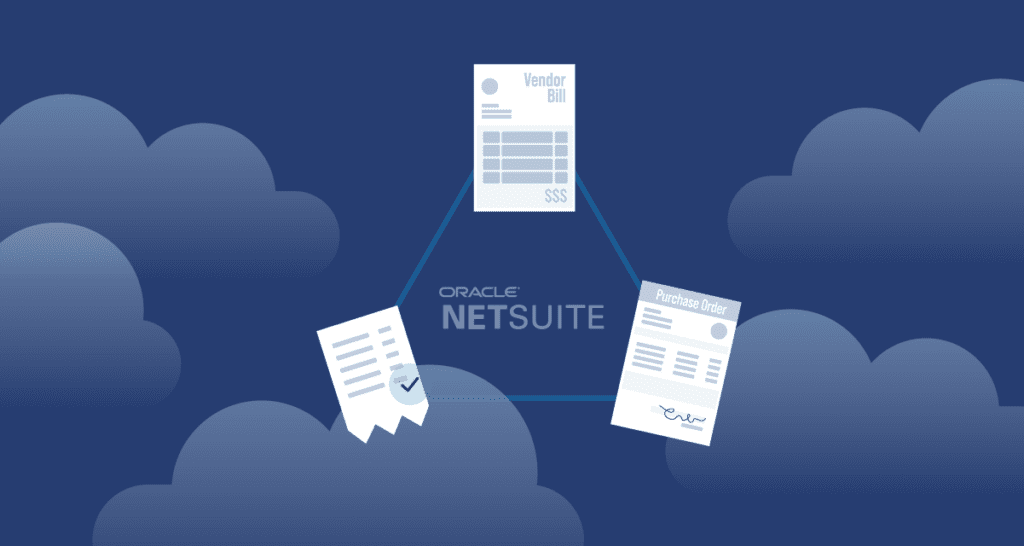
Matching purchase orders and invoices is one of the best defenses against fraud and errors. However, manual matching is a complex, time-consuming process. Many AP departments, already burdened with invoice processing tasks, may find it challenging to accurately and efficiently verify every PO and invoice.
Oracle NetSuite customers can leverage NetSuite’s built capabilities to automate PO matching tasks or opt for an integrated financial automation solution to make the process faster and more accurate.
In this article, we break out both options to help you understand the best way to handle PO matching in NetSuite. First, we’ll walk through the PO matching workflow in NetSuite and discuss its benefits and challenges. Then, we’ll compare NetSuite’s built-in solution with integrated financial processing automation systems to see which one is the best choice for your organization.
What is two- and three-way matching?
Two- and three-way matching helps AP departments validate the accuracy of invoice payments. Two-way matching compares the invoice to the purchase order (PO) to ensure header and line item details such as price and quantity match.
Three-way matching takes two-way matching a step further by also matching the invoice to the shipping receipt or goods received note (GRN) to ensure the goods received match the goods ordered and invoiced.
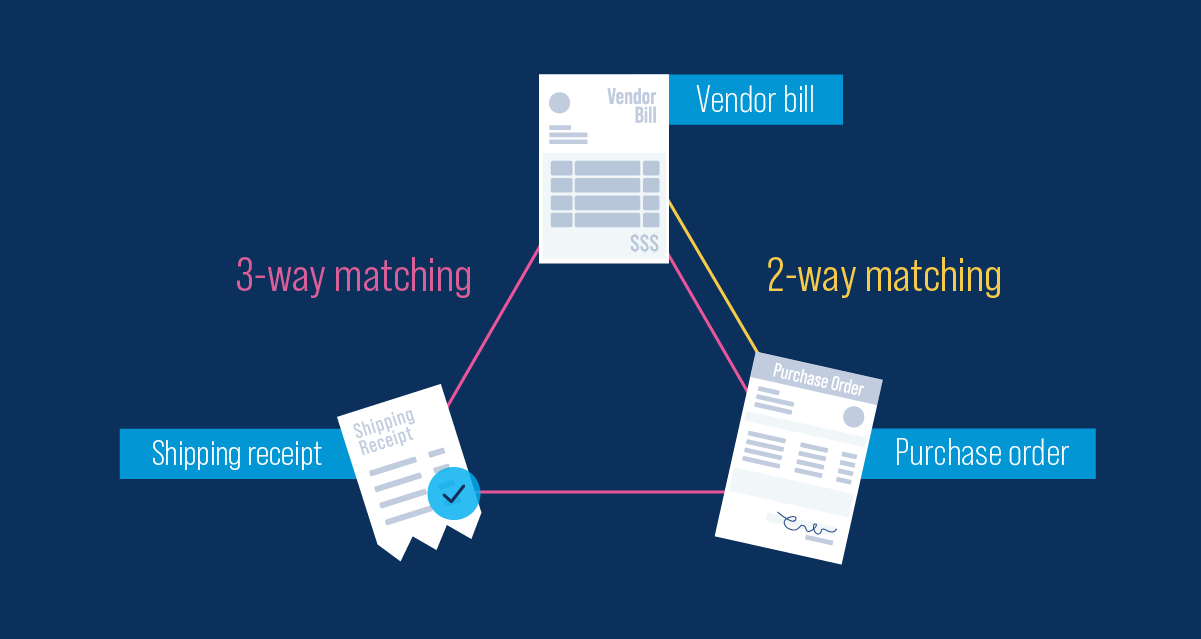
For example, BTB Corp issues a PO to Acme Business Furniture for 100 desk chairs at $100 each ($10,000). Acme ships 90 chairs and sends an invoice to BTB for 100 chairs for $10,000. When BTB’s AP team matches the invoice to the shipping receipt, they’ll find the discrepancy between the amount ordered and the amount shipped and billed and dispute the invoice with Acme.
How does PO matching work in NetSuite?
NetSuite automates two- and three-way matching using two built-in workflows that are available in the NetSuite Approvals Workflow SuiteApp. Two-way matching is performed by the NetSuite Vendor Bill Approval Workflow, and three-way matching is performed by the 3 Way Match Vendor Bill Approval Workflow. The 3 Way Match Vendor Bill Approval Workflow also provides additional two-way matching features.
Both matching workflows help NetSuite users identify exceptions between POs, vendor bills, and item receipts. Users can also customize both workflows to their needs.
Benefits of automating invoice matching in NetSuite
NetSuite lets you define exception criteria, approval policies, and user roles to control and streamline the PO matching process. This provides businesses with several benefits, including:
More efficient approval workflows
Automating PO matching in NetSuite optimizes approval workflows in two ways. First, it lets users set automatic approval rules where invoices that meet certain criteria are automatically approved for payment. Second, it eliminates manual approvals by sending invoices with exceptions to the appropriate approver for review.
Reduce fraud and errors
Customers can configure NetSuite to review every invoice, significantly improving fraud and error detection. If it detects an invoice exception, it halts processing for that invoice and flags it for review.
Maintain separation of duties
NetSuite allows customers to set and enforce user roles, maintaining separation of duties and reducing the risk of occupational fraud. For example, customers can give one user the ability to enter purchase orders and another the ability to process payments to ensure that no one user can approve and pay invoices.
Keep a complete audit trail
Like other ERPs, NetSuite automatically keeps records of transactions, approval histories, documentation, and communications, making it easier for auditors to review a bill’s history. Integrated AP automation platforms like Stampli also integrate with NetSuite to synchronize data and communications, ensuring data integrity across the organization.
PO matching roles in NetSuite
NetSuite automatically configures user roles after a customer installs the Approvals Workflow SuiteApp. Upon installation, the following roles are automatically provided access to custom records:
- CEO
- CFO
- Accountant
- Accountant (Reviewer)
- Bookkeeper
- Warehouse Manager
- AP Clerk
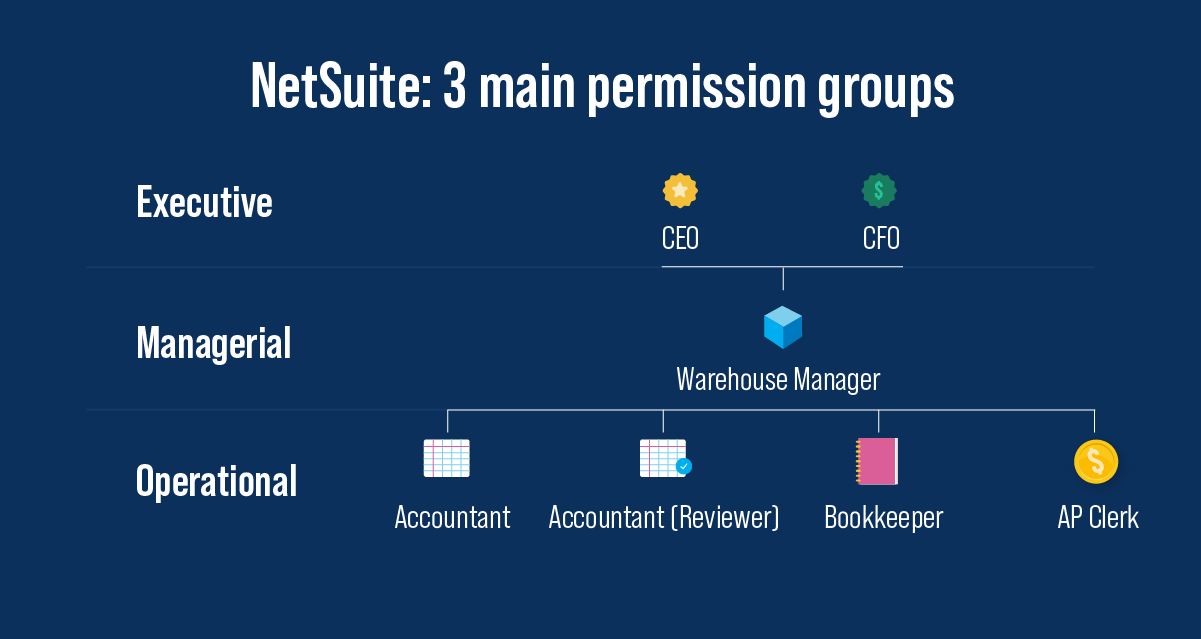
Customers can also enable users to approve bills by providing them with edit-level access and permissions.
In general, AP clerks enter vendor bill records and manage the PO matching process. Approvers, such as AP supervisors or executives, review bill exceptions and decide whether to accept or reject them. Warehouse Managers enter POs and item receipts to be used in the PO matching process.
Two-way matching: The NetSuite Vendor Bill Approval Workflow
NetSuite’s Vendor Bill Approval Workflow performs two-way matching. Vendor bills move through the workflow in five states.
1. Bill Validation
The vendor bill enters the bill validation state when it is entered by an AP clerk. When the bill enters this state, the workflow matches it with the PO and identifies whether there is a quantity or cost variance.
- If the workflow doesn’t detect a discrepancy, the bill moves to the approved state.
- If the workflow detects a discrepancy or the bill doesn’t have a PO, the bill is flagged as an exception and moves to the pending approval state.
2. Exceptions
The vendor bill transitions to the exceptions state if any of these criteria are met during two-way matching:
- The purchase order amount due is less than the bill amount due.
- The purchase order quantity is less than the bill quantity.
- The purchase order is only partially received.
When the workflow flags a bill for an exception, it adds an exception message to the Memo field on the bill record and sets the bill’s status to Pending Approval.
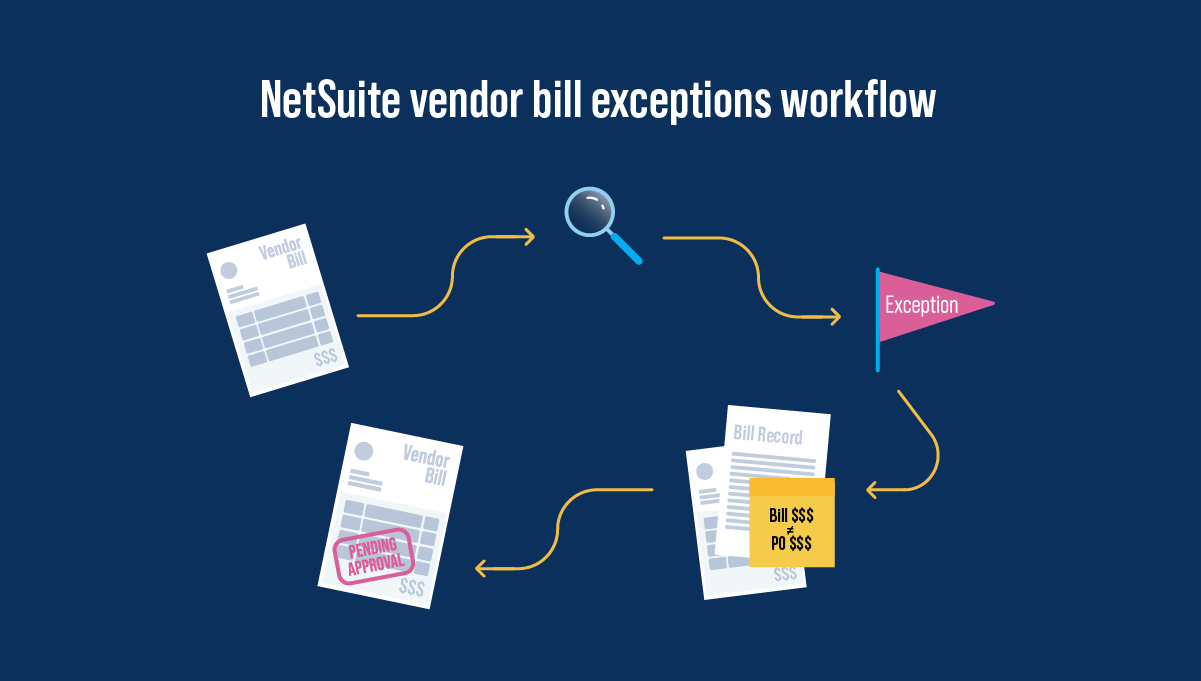
3. Pending Approval
If the workflow detects an exception, it flags the bill and sets its status to Pending Approval. An approver can then review the bill and approve or reject it.
4. Rejected
If an approver rejects the bill, the workflow sets its status to Rejected. NetSuite notifies the AP clerk that the bill has been rejected. The AP clerk can then amend the discrepancy and resubmit the bill.
5. Approved
If the workflow doesn’t detect any discrepancies between the PO and vendor bill, it automatically sets the bill status to Approved, notifies the AP clerk that the bill has been approved, and sends the bill for payment.
The NetSuite 3 Way Match Vendor Bill Approval Workflow
Like the two-way matching workflow, the 3 Way Match Vendor Bill Approval Workflow consists of states an invoice passes through during the matching process. The three-way match workflow is initiated when the AP clerk creates and edits the vendor bill, and it passes through eight possible states.
1. Approval Routing Feature Check
The bill approval workflow begins when the vendor bill is created and NetSuite confirms that the user is authorized to run the workflow. From there the bill moves to the bill validation state.
2. Bill Validation
In the bill validation state, NetSuite changes the bill status to Pending Approval and performs initial validation. Then the bill moves into the three validation states.
3. Validation state: Quantity Tolerance
In the quantity tolerance state, the quantities on the vendor bill, PO, and receipt are compared to see if they are within preset tolerance limits. For instance, in our example above, BTB may set a 1% quantity tolerance for desk chairs. BTB ordered 100 chairs, but Acme only shipped 90, a 10% difference. NetSuite would flag this bill as a quantity tolerance exception.
4. Validation state: Quantity Difference
In the quantity difference state, NetSuite checks for quantity differences between the vendor bill, PO, and receipt. Quantity differences above a pre-set quantity threshold are flagged as exceptions. For example, BTB sets their quantity difference threshold for deck chairs at one chair. Because Acme is billing for 100 chairs when they only shipped 90, NetSuite flags the bill as a quantity difference exception.
5. Validation state: Amount Validation
In the amount validation state, NetSuite checks for discrepancies between the total amounts of the vendor bill and PO. If the difference between the two amounts is greater than a pre-set threshold, NetSuite flags the vendor bill with an exception. For example, BTB sets its amount threshold at $5000. BTB issues a PO to Acme for 100 desk chairs at $100 each for a total amount of $10,000. Acme ships 100 desk chairs but sends BTB an invoice for $20,000. Since the difference of $10,000 exceeds BTB’s amount threshold of $5,000, NetSuite identifies the amount discrepancy and flags the bill for an exception.
6. Vendor bill status: Pending Approval
If any exceptions are detected and flagged during the validation process, NetSuite will set the vendor bill status to Pending Approval. Then it forwards the vendor bill, along with a list of exceptions, to the appropriate approver for review.
7. Vendor bill status: Rejected
If an approver reviews and rejects a bill, the bill enters the rejected state and is returned to the AP clerk. The clerk can either correct the bill and resubmit it for validation and approval, or they can cancel the bill.
8. Vendor bill status: Approved
If the approver reviews and approves the bill, it enters the approved state and is sent for payment.
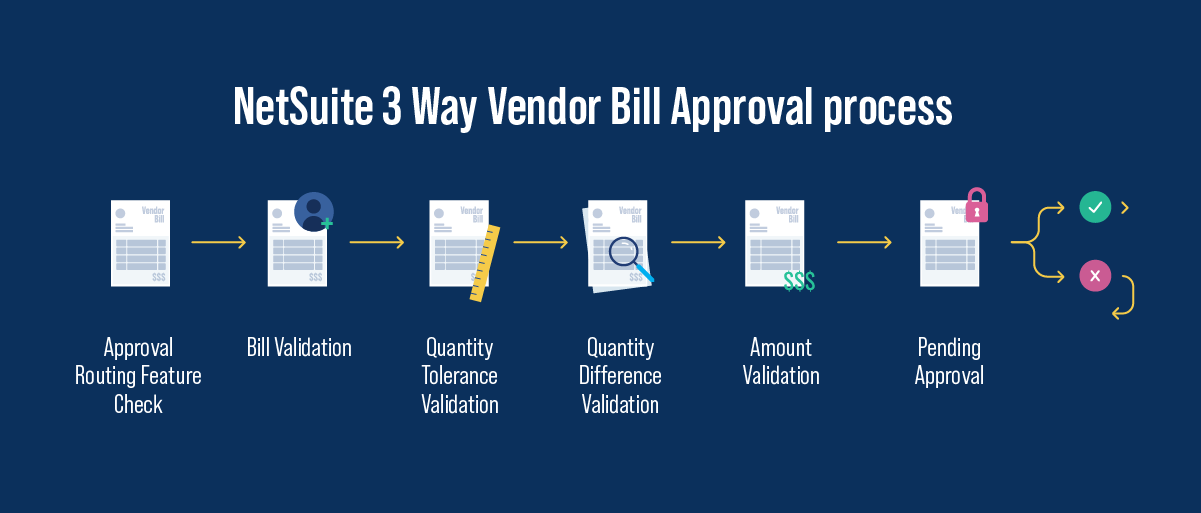
Challenges with NetSuite PO matching automation
NetSuite’s PO matching workflows are faster and more accurate than manually matching invoices to POs. However, they have several shortcomings that can limit their usefulness for AP departments. Let’s look at some of these shortcomings and discuss how an integrated financial automation platform may be a better choice for automating PO matching.
Complex workflows
NetSuite’s Vendor Approval Workflows are complex and difficult to navigate and configure. For example, customers must manually configure dozens of exception criteria before they can start using the 3 Way Match Vendor Bill Approval workflow.
One finance director complained that NetSuite’s complex structure causes problems down the road: “With advanced customization comes problems. We often have to contact premium support or our third party technical assistance. They can help us quickly navigate any challenges and create solutions, but at times, this does slow down the workflows.”
Another customer complained that NetSuite didn’t provide resources to help them implement workflows. “The implementation process was inadequate. There wasn’t sufficient analysis of the existing workflows by the NetSuite subject matter experts to determine (a) how NetSuite could accommodate existing workflows or (b) if existing workflows needed to change to accommodate NetSuite processes or perhaps leverage NetSuite features and functions.”
Leading AP automation platforms feature customizable and flexible workflows that don’t require IT rework or hiring outside consultations. One customer said Stampli’s approval workflow significantly improved their efficiency, saying that Stampli “allows our company to circulate invoices for approval with multiple departments that are spread across Southeast Alaska…It facilitates a solid bridge to get our invoices from received to approved to paid.”
Stampli is the only financial automation platform designed for how real AP teams work. It’s the fastest and smartest way to automate PO matching in NetSuite. One Stampli customer describes how Stampli has streamlined invoice verification at their company: “What I appreciate most about the Stampli system is its user-friendliness. It allows for seamless access to invoices from various vendors, with the added convenience of always having these invoices available on NetSuite, simplifying the process of searching for information.
“The automation feature is particularly impressive, as it eliminates the need to manually review all invoices—Stampli takes care of this, which is fantastic! Additionally, the ability to write comments, request information, and obtain approvals from one or more individuals enhances the collaborative and efficient nature of the system.”
Imprecise PO matching impairs exception handling
NetSuite’s PO matching workflows are rules-based and rely on invoice, PO, and receipt details matching exactly. If the details differ, it could trigger an exception, slowing the matching process. For example, BTB may issue Acme a PO for “100 desk chairs,” but Acme may send an invoice for “100 office chairs.” If NetSuite misses the different descriptions, it could fail to validate the invoice.
AP automation platforms use OCR and machine learning technologies to learn and understand invoice and PO details and make matching more efficient. Stampli’s AI copilot, Billy the Bot, learns your cost accounting rules and business processes to improve invoice processing accuracy and efficiency.
“Stampli has brought our processes forward a generation,” said an accounts payable manager in a recent G2 review. “Stampli’s incorporation of machine learning or A.I. (with Billy the Bot) has saved our team a lot of manual labor. We were previously coding all invoices manually, which included selecting the vendor information, invoice dates, and GL coding. Billy is like an added employee to our team! We also have an incredible amount of reporting for our AP department that wasn’t available through our last program.”
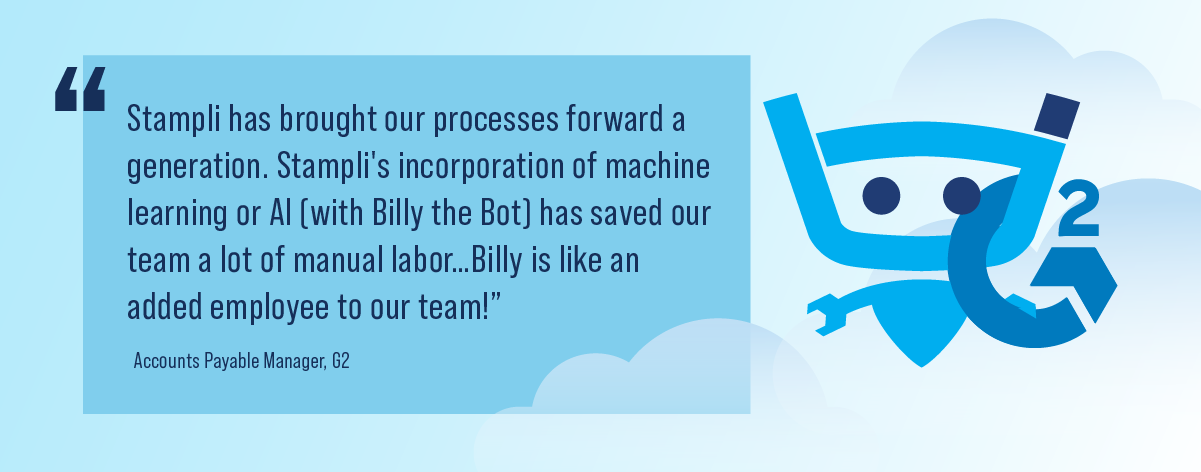
Complicated user interface slows processing
Like many ERPs, NetSuite is complex, with multiple menus, submenus, workflows, and settings. One NetSuite customer described the challenge: “Building reports and saved searches can be difficult and confusing to navigate. You have to go through many different drop downs to find the field you are looking for but it would be great, especially in a saved search, if you could search for the field name, even if it’s in another table.”
“NetSuite is so customizable that sometimes you don’t really know what you’re looking for,” says another customer. “This is very apparent when creating customized reports where the specific piece of information lives deep in some field that you have to find. I find myself doing a lot of trial and error in choosing which fields to bring in for reporting. NetSuite also requires that you have some back end knowledge to truly customize your experience. I have advised my companies in the past to hire NetSuite Admins to help write scripts for back end workflows.”
Leading financial automation platforms like Stampli feature intuitive, easy-to-use interfaces. They simplify complex AP tasks like PO matching by bringing invoices, POs, communication, and documentation together in one place. In a recent review, one financial manager described how Stampli’s design has transformed their AP workflow: “What I appreciate most about Stampli is its intuitive interface and seamless integration into our accounts payable workflow. It has significantly simplified the submission and approval of invoices, eliminating many of the cumbersome steps that used to slow us down…Its ease of use stands out; Stampli has made it possible for our team to manage our invoicing process more effectively, allowing us to allocate our time to other critical tasks. The impact on our productivity has been remarkable, making Stampli an invaluable tool in our AP processes.”
Faster and smarter NetSuite PO matching with Stampli
Stampli is the fastest and smartest way to automate PO matching and the entire AP process in NetSuite. It augments NetSuite’s native functionality by providing total visibility and control over two- and three-way matching processes. Stampli’s pre-built integration is Built For NetSuite (BFN) certified and supports all tables, lists, and workflows in NetSuite without reworking your ERP. Stampli expedites PO matching in NetSuite by automatically syncing GL accounts, suppliers, departments, locations, and even custom fields between Stampli and NetSuite ERP — ensuring AP teams have the information they need to verify invoices.

“An amazing solution!”
In a recent review, a financial controller called Stampli, “An amazing solution!” They described how Stampli works seamlessly with NetSuite to optimize their approval process: “We have been using Stampli for close to three years now, and we’ve literally had zero issues. The connection with NetSuite is seamless, any updates/upgrades we want to do are easy to implement and everyone in the company is very happy with the approval process.
“Overall, it’s a great product that does exactly what’s advertised — Make the AP function more efficient and easier for everyone!
“Finally, on the odd occasions where we needed some customer support (for trivial issues), I couldn’t have asked for a better team. They were always helpful, quick to reply and very accommodating!”
Intelligent invoice processing for NetSuite
Stampli provides end-to-end invoice processing automation for NetSuite customers. When an invoice is approved in Stampli, Stampli’s NetSuite integration automatically generates a vendor bill in NetSuite with a link to the invoice in Stampli. After the vendor bill is processed and paid in Stampli, Stampli automatically generates the payment against the open vendor bill(s) in NetSuite. Alternatively, if you process the invoice in Stampli and then pay it in NetSuite, the invoice will be automatically marked paid in Stampli.
Stampli automatically captures invoices and stores them in a centralized platform to optimize and simplify document management. It supports matching against single or multiple POs and supports adjustable line level detail and real-time sync of receiving status notifications.
One customer said Stampli “has been a massive win for us, from its seamless interface with our accounting software to its straightforward invoicing approval process. Its clear, user-friendly interface and exceptionally detailed layout make managing invoices a breeze. We now have more control over our budget and greater operational efficiency thanks to the system’s ability to display invoices awaiting approval, monitor overdue invoices, and provide instant access to all invoices that have been approved.”
Flexible and scalable workflows
Many platforms (including NetSuite) only provide fixed approval routing options with limited customizability. If approval policies change or an approver isn’t available, changing the approval workflows can require a lot of rework.
NetSuite customers can configure custom invoice approval workflows and templates in Stampli to meet their unique matching and approval requirements. Stampli offers fixed and dynamic approval workflows that learn your existing processes and automatically adapt when things change.
“Stampli is…superior!” said a happy Stampli customer on GetApp. “We used to forward and email invoices to managers for approval, and Stampli has automated that process…The automatic coding of GL accounts; the ability to create an approval workflow based on levels of authority and dollar limits; the approval routing itself; the reporting. Also, no more paperwork! Digital copies are all available for audit purposes.”
Contact one of our AP experts today to learn how Stampli can help you optimize NetSuite PO matching for your business.